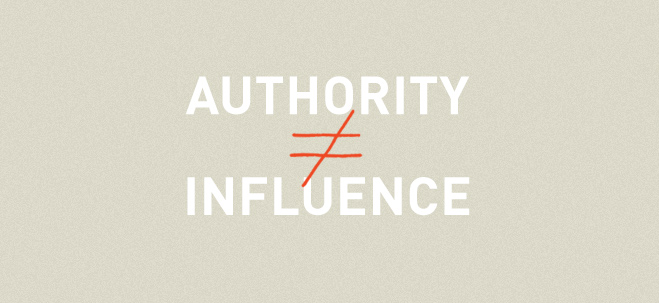
Influence: How Leaders Easily Accelerate Results
“How can I lead someone if I don’t have any authority?” I’ve heard that question repeatedly over the years from individuals inside all kinds of organizations—from hierarchies and bureaucracies to matrix and network-oriented structures.
The question itself raises an issue about how we define leadership influence—the natural ability to have an effect on others within the context of relationships—and authority—the power that comes to someone through hierarchical position or subject matter expertise.
Exerting authority is management.
Influencing is leadership.
This is a critical distinction worth making. I interpret authority as the dynamic tension between command and control, coercion and compliance, or direct and do—pick your language. However you choose to refer to it, authority is distinctly different from leadership influence, which is irrespective of hierarchy, position, or expertise. Once we see this difference, we can learn how to influence without authority. This is where we can develop genuine leadership ability—something especially valuable in the context of hierarchical organizations, where the absence of this distinction in relationships frequently has people operating disempowered.
Effective leadership in hierarchies
True leadership has nothing to do with hierarchy. The formal chain of command is a managerial construct that often has a tendency to actually inhibit leadership.
Leadership with hierarchy imposed on it shows up as command-and-control style relationships. It’s almost a foregone conclusion that individuals who are lower ‘ranked’ in such hierarchical relationships will feel, at some point, as if their dignity has been compromised. When this way of relating to the ‘lower’ person in the hierarchy devolves into coercion and compliance, the relationship itself becomes compromised and may not be sustainable over the long-term.
Effective leaders transcend hierarchy and create solid respectful, partnership-based relationships that help everybody thrive—and that deliver results.
Influence with authority is coercion.
Influence without authority is influence.
In my executive coaching conversations, I hear over and over again people wanting “to learn to influence without authority.” I love what this reveals about the culture of their organization—how hierarchy determines the context for what constitutes effective influence—and, at the same time, it troubles me. It troubles me because it tells me that we are not effectively relating to each other in our organizational relationships as co-creators of the future.
While you may have experienced influencing or being influenced in a hierarchical relationship, I suspect that the result is not sustainable…nor does it resemble a relationship that you’re happy to be a part of. Real leadership and genuine influence comes from a foundation of robust relationships based in mutual respect and built around a shared set of goals and commitments. Without genuine influence, achieving our higher organizational outcomes becomes extremely difficult.
Leadership in conversations
Anyone can influence another through conversation. And leadership happens in conversation—bilaterally—regardless of whom we refer to as the titular leader.
Can you have a conversation with a colleague without exerting some form of hierarchical authority (read: threat) and influence them in some way that is meaningful and mutually agreed upon? Do we really need the threat of authority in order to get people to do what we want them to do?
I think not.
So what is missing?
In every conversation you have in any organizational relationship you’re in, influence happens as a function of the health of that relationship. The norms of interaction, the understanding of expectations and commitments, the level of clarity about what you’re mutually committed to: these elements of relationship are nurtured iteratively in every conversation at the same time that action is being coordinated and business is being transacted.
If a working relationship is healthy, robust, and mutually defined, then influence will be based on these elements. If a relationship is not robust and the norms of the relationship have not been discussed and established, influence will only be possible through some form of coercion—another instance of influence without authority.
Is some aspect of “authoritarian” discourse compromising the health of any of your key relationships at work? Perhaps now is the time to invest in working with an executive coach to master creating your network of sustainable, resilient relationships.